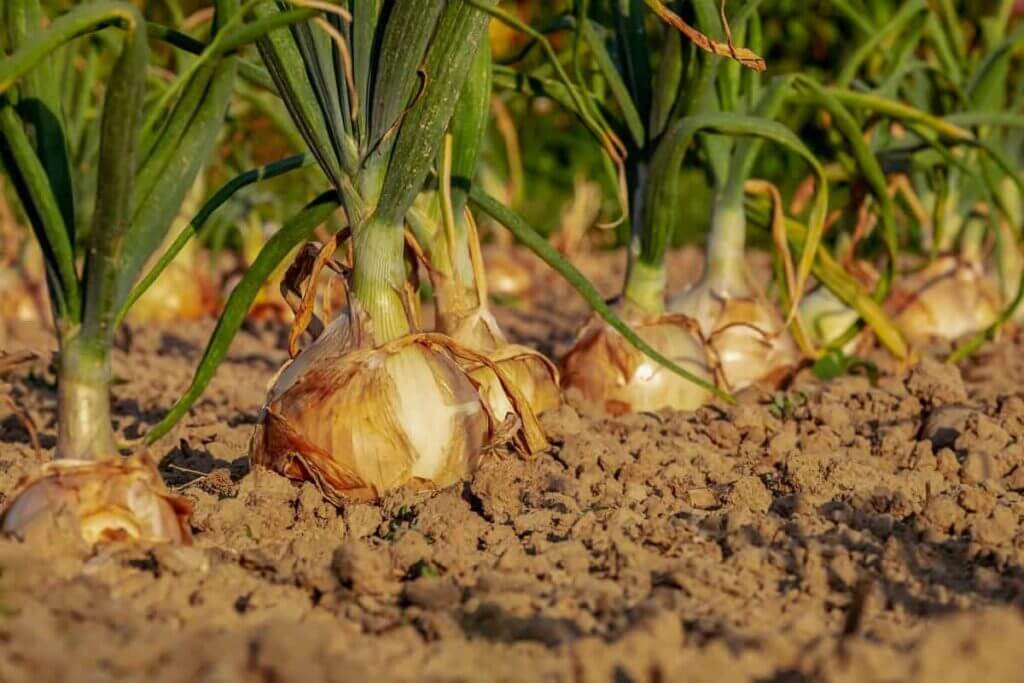
Onions are a versatile and widely cultivated crop, but they are susceptible to various diseases and pests that can significantly impact their yield and quality. Being aware of these potential threats and understanding how to identify, prevent, and manage them is essential for successful onion farming. In this comprehensive guide, we will explore the common diseases and pests that affect onion farming, along with practical strategies for disease and pest management.
Common Onion Diseases:
1.1. Downy Mildew (Peronospora destructor):
- Symptoms: Yellow-green patches on leaves, purple-gray fuzz on the undersides, stunted growth, and reduced bulb size.
- Management: Plant disease-resistant onion varieties, practice crop rotation, provide proper spacing for good airflow, and apply fungicides when necessary.
1.2. White Rot (Sclerotium cepivorum):
- Symptoms: Wilting, yellowing, and rotting of leaves, brown lesions on bulbs, and white fungal growth.
- Management: Practice crop rotation with non-allium crops, remove and destroy infected plants, avoid excessive irrigation, and use disease-free sets/seeds.
1.3. Fusarium Basal Rot (Fusarium oxysporum):
- Symptoms: Yellowing, wilting, and death of outer leaves, brown discoloration at the base of bulbs, and bulb decay.
- Management: Plant disease-resistant varieties, practice crop rotation, provide proper drainage, avoid overwatering, and sterilize equipment to prevent spread.
1.4. Botrytis Leaf Blight (Botrytis squamosa):
- Symptoms: Water-soaked lesions on leaves, grayish-brown fuzzy growth, leaf death, and bulb infection.
- Management: Maintain good airflow, practice crop rotation, remove and destroy infected plant material, and apply fungicides as needed.
Common Onion Pests:
2.1. Onion Thrips (Thrips tabaci):
- Symptoms: Silver-gray speckling and curling of leaves, stunted growth, and reduced bulb size.
- Management: Use yellow sticky traps, practice crop rotation, employ reflective mulches, and apply appropriate insecticides.
2.2. Onion Maggots (Delia antiqua):
- Symptoms: Wilting, yellowing, and stunted growth of plants, swollen and discolored roots, and tunneling in bulbs.
- Management: Use floating row covers, practice crop rotation, avoid excessive nitrogen fertilization, and apply insecticides if necessary.
2.3. Onion Flies (Hylemya antiqua and Hylemya platura):
- Symptoms: Yellowing and wilting of leaves, maggots feeding on roots and bulbs, and plant death.
- Management: Practice crop rotation, use sticky traps, cover seedlings with screens or row covers, and apply appropriate insecticides.
2.4. Onion Thrips (Thrips tabaci):
- Symptoms: Silver-gray speckling and curling of leaves, stunted growth, and reduced bulb size.
- Management: Use yellow sticky traps, practice crop rotation, employ reflective mulches, and apply appropriate insecticides.
Onion farming can be significantly affected by diseases and pests, leading to reduced yields and lower-quality produce. However, with knowledge about the common diseases and pests that affect onions, along with effective management strategies, farmers can mitigate the risks and ensure a healthier onion crop. Implementing good agricultural practices such as crop rotation, maintaining proper plant spacing, practicing good hygiene, and using disease-resistant varieties can go a long way in preventing and managing diseases. Additionally, monitoring for pests, implementing cultural controls, and utilizing targeted insecticides when necessary can help minimize pest damage. By staying vigilant and proactive, onion farmers can safeguard their crops and achieve successful and sustainable onion production.
Stay updated with the latest farming tips and agriculture industry news from Africa by subscribing to our newsletter. Don’t miss out on valuable insights and updates. Follow us on Twitter, LinkedIn, and Facebook to join our farming community and stay connected with us.




















Leave a Reply